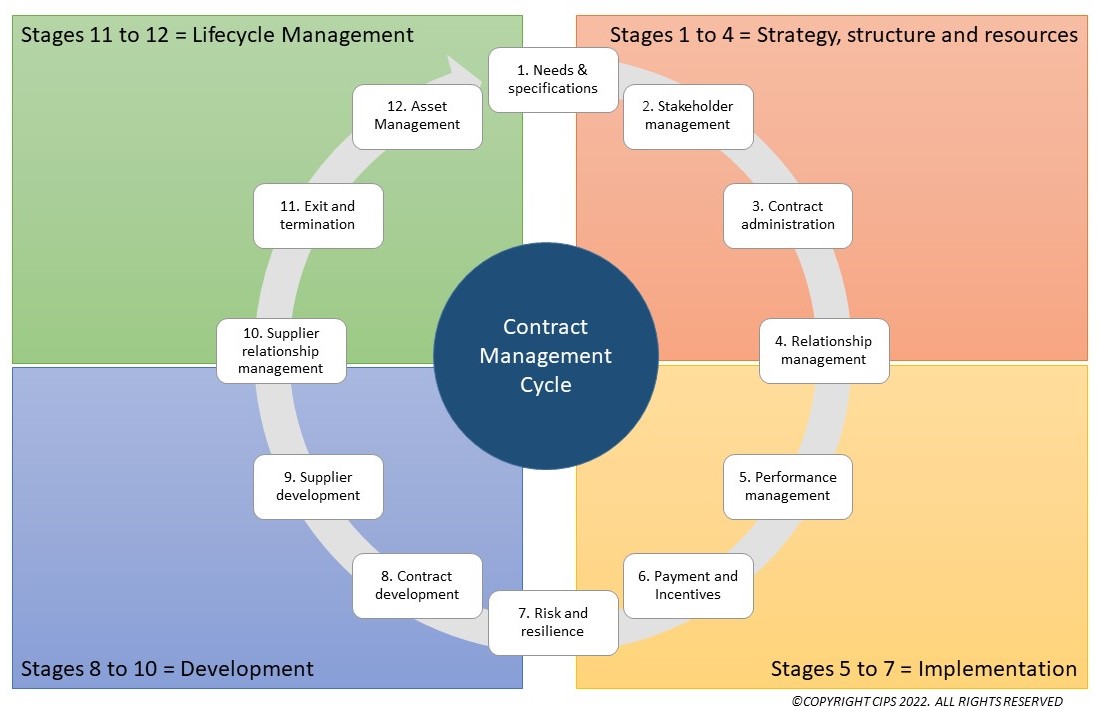Understanding the Contract Management Cycle
FM Contracts manages the process from contract inception to termination, optimising operational and financial performance while minimising risk
We conform to best practice recommended by the Chartered Institute of Procurement and Supply. This is explained in more detail in the Contract Management Cycle, below.

Stage 1 - Define business needs and develop specification
Stage 2 - Stakeholder management
Stage 3 - Contract administration
Once the Purchasing Department has completed the tender process, we start to prepare the resources, processes and procedures to manage the contract. It is important the specification work completed in Stage 1 is reflected in the terms and conditions of the contract. The work in this stage may inform the way we want the contractor to work, therefore it's important to communicate these requirements during the contract mobilisation and implementation phase.
Stage 4 - Relationship management
The process of constantly reviewing the needs of stakeholders and customers is fundamental to a good relationship between stakeholders. This allows the contract to evolve over time and continually satisfy those needs. This stage relates to Oxford University stakeholders and customers only, and is not to be confused with supplier relationship management in Stage 10.
Stage 5 - Performance management
Developing a suitable performance management regime to measure the key aspects of a contract is essential for stakeholders and customers to understand how the contract is performing at any given point in time. This will help inform robust decision-making to change and evolve the contract, and ensure the contract remains fit for purpose.
Stage 6 - Payment and Incentives
The financial management and associated processes and procedures will depend on the commercial dynamic of the contract. Each process is informed by robust internal pre-defined financial protocols for each contract.
The financial management and associated processes and procedures will depend on the commercial dynamic of the contract. This process is illustrated in the Contracts Management Cycle document in more detail, showing an example only. Each process is informed by robust internal pre-defined financial protocols for each contract.
Stage 7 - Risk and resilience
Every contract has risk attached to it. The management and control of this risk is essential to the sustainability and success of the contract. The Contracts team support and help in understanding risk to inform decision-making and facilitates positive change and evolvement of the contract over time.
Stage 8 - Contract development
Contracts will need to evolve and develop over their term, particularly those of five years or more. This is inevitable to address current challenges, whether internal (e.g. stakeholder and business need) or external (e.g. threats and legislative changes).
Stage 9 - Supplier development
In the same way the contract must develop in Stage 8, so must the supplier by following a process of continuous improvement. We work closely with our suppliers to develop their capacity and capability to deliver a sustainable and successful contract.
Stage 10 - Supplier relationship management
In the same way we manage internal stakeholder and customer needs in Stage 4, we are also receptive to the needs of the supplier as a valued external stakeholder. We must be sympathetic to the issues and challenges they may be facing and consider recommendations for contract improvement.
Stage 11 - Exit and termination
There are different reasons why a contract may be terminated - for example, break clauses and poor performance. Whatever the reason, it is essential that sufficient time and resources are assigned to the process. Demobilisation of the current supplier and mobilisation of another poses various challenges and risk that must be carefully coordinated and managed.
Stage 12 - Asset management
At the end of a contract, it is important to reconcile and account for assets owned by the University but previously managed by the supplier. The University will want to ensure its assets have been operated and maintained, and any shortcomings recovered from the supplier. In the case of stock such as spare parts, an inventory and suitable storage should be available.
To understand each stage in more detail, please refer to the Contract Management Cycle document.
Find out more
To view and access the Estates Services service catalogue
Related links
Get in touch
Want to know more about our contracts?
Richard Alexander, Head of Contracts
07342 709372
richard.alexander@admin.ox.ac.uk
Max Horner, Contracts Manager
07775 026875
Romana Hafeez, FM Contracts Coordinator
07464 529777


